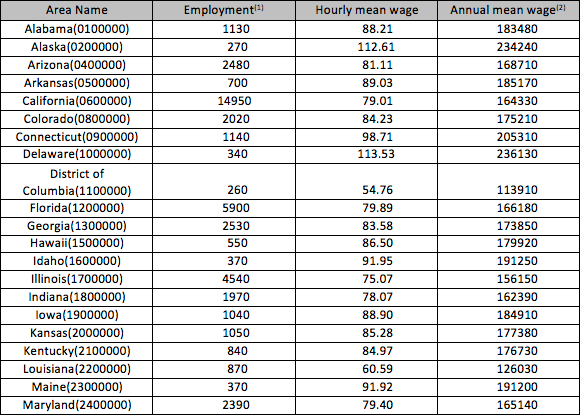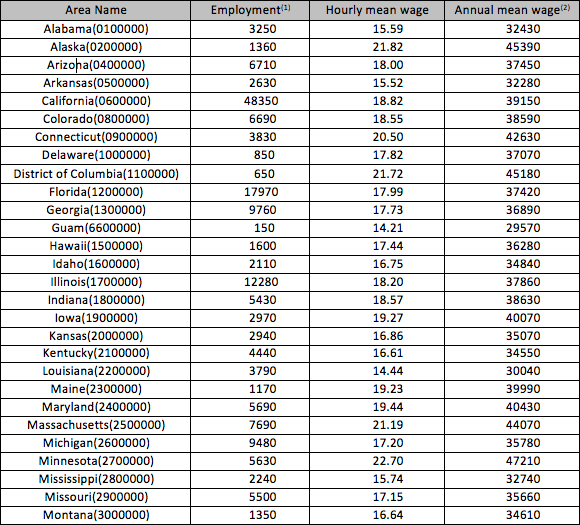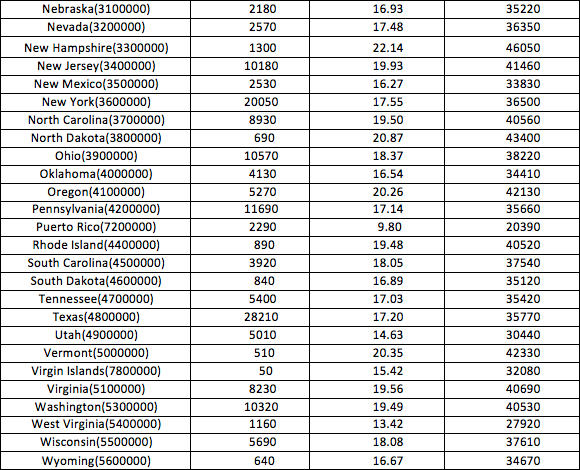The latest hourly and annual salary numbers for dentists and dental assistants
Looking at the most recent data from the US Bureau of Labor Statistics – and what it means to you. In order to be a dentist – or anyone in the healthcare field, for that matter – one has to want to help others. And while there is an altruistic element to the work, the fact remains that dentists want to get paid for their hard work.

In order to be a dentist – or anyone in the healthcare field, for that matter – one has to want to help others. And while there is an altruistic element to the work, the fact remains that dentists want to get paid for their hard work.
In 2016 there were more than 105,000 dentists, and if the research holds true, that number will grow almost 20 percent by 2024. Those numbers are from the most recent US Bureau of Labor Statistics report, which reveals a lot of great information about the dental profession, telling us where the most (and least) amount of dentists practice, where they are paid the most (and least), and what kind of outlook the profession can expect. (Spoiler: It’s good… REALLY good).
Related reading: See how the salary numbers from 2014 stack up against today's averages
How much are dentists getting paid
Let’s take a look at the big picture, first. According to the Bureau of Labor Statistics, in 2016 the median annual salary for dentists was $159,770 or $76.81 per hour.
Not surprisingly, dentists make the most out of everyone else on the dental team – hygienists made an average of $73,440, dental lab technicians made $40,760 and dental assistants made $36,940.
But the title “dentist” in this case is a blanket term applied to all specialties. When we break down salaries further, we get more exact earnings. Based on the data, dentists in the following specialties earned:
· Orthodontists -- $208,000 or more
· Oral and maxillofacial surgeons -- $208,000 or more
· Dentists, all other specialists -- $173,000
· Dentists, general -- $153,900
· Prosthodontists -- $126,050
Trending article: The states with the best and worst dental health
Of course, earnings varied by the doctor’s location, the number of hours worked, his or her specialty, and the amount of experience.
Not surprisingly, the bulk of dentists (95,330) work in conventional dental offices. However, that is not the only place where dentists can be found. The data also shows dentists working in places like physicians’ offices (2,770), outpatient care centers (2,540) and hospitals (1,500). The highest paid setting was for those 30 dentists that work in “Residential Intellectual and Developmental Disability, Mental Health, and Substance Abuse Facilities”. They earned an average of $184,620.
Next: How it breaks down by location
Where they work
Maybe it’s the surf, the sun or the movie stars, but California was home to the most dentists – 14,950 – with an annual salary of $164,330. In second place was Texas with 8,420 and New York has slightly fewer dentists with 7,710. They earned $171, 850 and $170,300, respectively.
Most of New York’s dentists (6,010) are located in the New York-Jersey City-White Plains region. Obviously, that region isn’t just accounting for New York doctors as it also includes portions of New Jersey. Of California’s almost 15,000 dentists, 3,790 work in the Los Angeles region.
But location doesn’t necessarily correlate to salary. For instance, Vermont had the fewest dentists – just 170 – but earned almost $26,000 a year more than the national average ($185,560 per year). Delaware – also with a relatively low number of dentists (340) – boasts the highest salary -- $236,130 per year ($113.47 per hour).
It looks like North Carolina is a really great place to be a dentist – there were 3,190 earning $236,020 per year ($113.47 per hour).
Related reading: The best and worst states to work in a dental practice
A population that needs dentists
The outlook for dentists is very positive, and a lot of that demand can be attributed to the Baby Boomers. In 2014 there were 131,500 dentists and the profession is expected to grow to 178,200 by 2024. This is an 18 percent growth, which is much faster than the average for all occupations.
This growth is attributed to demand for dental services as the population ages; cosmetic dental services are expected to become even more popular; and as access to health insurance continues to grow.
This growth will mean higher demand for others in the profession. With more dentists will come the need for more hygienists and assistants. Also, someone will need to make the crowns and bridges for those doctors’ patients – thus a need for more dental lab technicians.
Doctors will see more work and productivity from new technologies – like digital dentistry – which will reduce the amount of time needed to see individual patients. The result is expected to be an expansion of their practices and the ability to see more patients.
It seems that patients’ good dental habits in the past will fuel the need for more dentists in the future. The aging Baby Boomer generation, overall, did a nice job keeping their teeth – more so than earlier generations – and someone needs to continue that care in the years to come.
Further, with more advanced dental work being available – like implants, for instance – doctors will also be needed for those procedures. And, as the risk of oral cancer increases with age, compilations from such cases will necessitate cosmetic and functional dental work.
Trending article: New CDC study finds high periodontal disease prevalence in Southern U.S. states
Cosmetic dentistry is becoming more popular, and there will continue to be a need for doctors who offer teeth-whitening, veneers and so forth. This trend is expected to grow as technologies, products and services make these procedures more accessible.
Additionally, many dentists are expected to retire in the next decade (again, the Baby Boomers) and replacements will be needed to fill those positions.
Technology brings an interesting twist to the profession, while, at the same time, offering a great opportunity. With technological advances becoming more and more prevalent, dentists will have to be able to embrace that type of work. Happily, newly graduating dentists have grown up with computers and are no strangers to the changing face of technology, so they will be ready with those skillsets and be comfortable as technologies evolve and change.
Next: The stats broken down by state
Dental salary statistics



Next: Salary numbers for dental assistants
Dental assistants
Call them the Robins to the dentists’ Batmen. Dental assistants work side-by-side with dentists and a lot of their data mirrors the dentists – it almost has to. There were 327,290 dental assistants in 2016, up from 318,800 in 2014. Like dentists, that number is expected to grow 18 percent by 2024.
In 2016, dental assistants made an average $36,940 per year (or $17.76 per hour), and most worked in dentists’ offices. But the best pay was for those 3,930 working for the Federal Executive Branch. They earned an average of $40,570 per year.
Trending article: Survey says: How dental assistants really feel about their dentists
Location, not surprisingly, mirrored the top three locations for dentists: California (48,350), Texas (28,210) and New York (20,050). But the top paying states differed from this list, completely. The top earning dental assistants were in Minnesota ($47,210), New Hampshire ($46,050) and Alaska ($45,390).
In the years to come, the dental profession offers a lot of opportunities – between patient demand and on-the-job advancements, there will be plenty of work and enough to keep the doctor interested and engaged.
Dental assistant salary statistics


Episode 31: Dentsply Sirona Implant Announcements
September 30th 2021DPR’s Editorial Director Noah Levine sat down with Gene Dorff, Dentsply Sirona’s group vice president of implants and Dr. Dan Butterman to review several big announcements the company made in the arena of implants during Dentsply Sirona World 2021 in Las Vegas.
Oral Health Pavilion at HLTH 2024 Highlighted Links Between Dental and General Health
November 4th 2024At HLTH 2024, CareQuest, Colgate-Palmolive, Henry Schein, and PDS Health launched an Oral Health Pavilion to showcase how integrating oral and general health can improve patient outcomes and reduce costs.